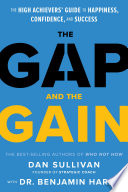

The authors argue that many individuals measure their success by comparing themselves to ideal standards or others, which leads to the Gap mindset. Instead, they advocate for measuring progress based on personal growth and achievements over time. This shift in perspective not only fosters a more positive outlook but also motivates continuous improvement. By setting benchmarks based on past performance rather than external comparisons, individuals can cultivate a more fulfilling and productive mindset.
Continue readingThe central premise of 'The Gap and The Gain' is the distinction between two mindsets: the Gap and the Gain. The Gap refers to the space between where you are and where you want to be, often leading to feelings of inadequacy and dissatisfaction. In contrast, the Gain represents the progress you have made, encouraging a sense of accomplishment and gratitude. This idea emphasizes the importance of shifting focus from what you lack to what you have achieved, which can significantly enhance your overall happiness and motivation.
Continue readingGratitude is a powerful tool in transitioning from the Gap to the Gain. The book discusses how acknowledging and appreciating your progress can enhance your mental well-being and drive. Practicing gratitude helps to reframe your mindset, allowing you to see the value in your efforts and achievements. The authors suggest incorporating daily gratitude practices to reinforce this shift, ultimately leading to greater satisfaction and motivation in both personal and professional realms.
Continue readingSetting goals is crucial for personal and professional development, but the authors emphasize the need for reflection on these goals. They encourage readers to regularly assess their progress and celebrate small wins along the way. This practice not only reinforces the Gain mindset but also helps individuals stay aligned with their long-term objectives. By reflecting on achievements, individuals can better understand their journey and adjust their strategies for future success.
Continue readingThe book highlights the significance of a growth mindset in overcoming the Gap mentality. A growth mindset involves viewing challenges as opportunities for learning and improvement rather than obstacles. The authors provide strategies for developing this mindset, such as embracing failure, seeking feedback, and staying curious. By fostering a growth mindset, individuals can navigate setbacks more effectively and maintain motivation in their pursuit of goals.
Continue readingThe authors explore how one's environment influences mindset and overall well-being. They argue that surrounding oneself with positive influences, such as supportive relationships and inspiring communities, can help reinforce the Gain mentality. Conversely, negative environments can perpetuate feelings of inadequacy and stagnation. The book encourages readers to evaluate their surroundings and make conscious choices about who and what they allow to impact their mindset.
Continue readingThe book concludes with practical strategies for implementing the Gap vs. Gain framework in daily life. These strategies include setting realistic goals, maintaining a gratitude journal, regularly reflecting on progress, and surrounding oneself with positive influences. By incorporating these practices, individuals can gradually shift their mindset, leading to greater fulfillment and success in various aspects of life.
Continue reading